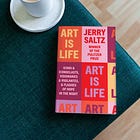Finding a job in any industry is hard but with the exclusive circles and opaque hierarchies of the art world, landing a role can seem like an insurmountable challenge. Don’t lose faith! With a strategic approach and persistence, securing a position in the field IS possible.
Here are five essential steps to guide you on your journey:
Step 1: Understand the Landscape
Before diving headfirst into the competitive art world job market, take the time to familiarise yourself with the main players in the field. Galleries, dealers, collectors, and museums are the cornerstone entities that comprise the art ecosystem. Understanding their roles and how they interact with one another is crucial for navigating the industry effectively.
By researching key personalities and the trends shaping the current art landscape, you can gain a comprehensive understanding of the most influential institutions and figures to reach out to for perspective roles.
If you’re looking for recommendations, check out our previous post detailing our top five recommended books that provide great insight into the art world.
Step 2: Start Small with Internships or Work Experience
One of the best ways to gain practical experience and enhance your skill set is by starting small. Look for internship opportunities or entry-level positions at smaller art spaces, galleries, or auction houses.
Working in a small team environment requires a hands on approach and exposes you to a wide range of aspects of the art business, from administrative tasks to client interactions. Even if the role seems mundane at first, every experience adds valuable insights and credibility to your CV. It is widely known that interns are the first pool of people that employers look to when filling a role within the same company.
For an extra helping hand, sign up with the below recruiters who specialise in roles for the art world:
Step 3: Customize Your Applications
When applying for jobs, personalise your applications to each company or institution. Draw connections between your skills and experiences and how they align with the company's goals or vision. For example, if you have experience working in a magazine shop, you can emphasise that through your love of art magazines you have familiarised yourself with the artists that the hiring institution works with. Or perhaps you have seen that the gallery or auction house you are applying to just had a record breaking sale—mention this in your application and relate it to your interests or past experience.
By researching the organisation thoroughly and highlighting their recent achievements or notable projects, it shows that you are invested in their business and knowledgeable about the latest developments in art.
Stay up to date with art world headlines via these channels:
Step 4: Network, Network, Network
In the art world, relationships are paramount. Reach out to professionals in the field, whether through social media, industry events, or mutual connections. People love to share their experiences and offer guidance, especially if they see potential in emerging talent. Be proactive in seeking informational interviews or arranging coffee meetings with individuals whose careers you admire. Show genuine interest in their work, and don't hesitate to ask for advice or insights about breaking into the industry.
Who in the art world would you most like to meet with?
Step 5: Excel in Your Role and Build Your Reputation
Once you've landed a job, regardless of its scope or seniority, give it your all. Be proactive, enthusiastic, and willing to go above and beyond what is expected of you.
Take initiative, anticipate the needs of your colleagues, and strive for excellence in every task you undertake. Building a reputation as a dedicated and reliable team member opens doors to new opportunities and fosters positive relationships within the industry. Every interaction is an opportunity to leave a lasting impression.
In conclusion, while breaking into the art world job market may seem daunting, it's certainly achievable with the right approach and perseverance.
By understanding the industry landscape, gaining practical experience, customising your applications, networking effectively, and excelling in your role, you can carve out a fulfilling and dynamic career.
Good luck!




